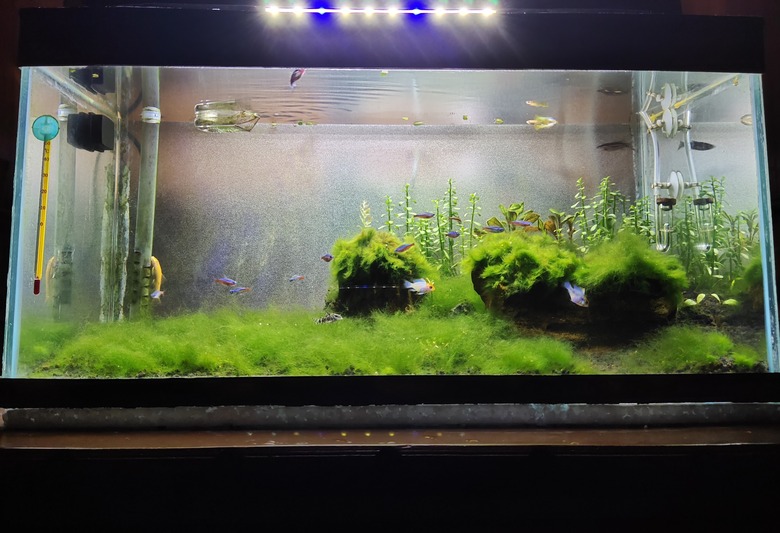How To Remove Hard Water Stains From Fish Tanks
Hard water stains can appear on metal or glass surfaces, including fish tanks. Hard water buildup, also called mineral deposits, lime scale, or calcium buildup, usually appears on aquarium glass near the water surface. These chalky stains can dull the appearance of your aquarium and cloud the view of the fish, especially under an aquarium light.
Hard water stains on a fish tank are hard to remove, but it's not impossible. Scrubbing with nontoxic chemicals is necessary, although using a water softening system in your home will reduce the amount of minerals in the tap water you add to your aquarium. Note that calcium deposits are different from greenish algae buildup, which can be reduced by adding pleco fish to your tank.
Hard water stains on a fish tank
Hard water stains on a fish tank
Hard water stains look like white chalk coating the surface of the aquarium glass. These stains are left behind when water evaporates, and only the mineral content of the water remains. Hard water — or water containing minerals, such as calcium and magnesium — stains fish tank glass more than soft water. Soft water is tap water filtered through a softening system before it is added to the tank.
Hard water stains on a fish tank are most noticeable when the water level of the tank goes down, or evaporates, leaving behind a line or smudge of white opaque deposit. Quality fish tank filters can also help reduce this cloudy buildup.
Removing calcium deposits from aquariums
Removing calcium deposits from aquariums
One of the most effective ways to clean hard water stains on a fish tank is to use an aquarium glass scraper designed for this purpose. Also called algae scrapers, they can be purchased at pet stores, especially those with aquarium departments. It's recommended you only use this tool, as other tools will scratch the glass surface. Do not use chemical cleaners designed for bathrooms because these will kill your fish no matter how much you rinse the tank.
First, remove the fish from the tank. Then, scrape as much of the hard water deposits from the side of the tank as possible; this require some effort. If necessary, you can also use a mixture of 1 cup of white vinegar with a gallon of water (very diluted) and spray or wipe it onto the surface of the glass. Continue to rub with a soft cloth or let the tank soak for a while. This solution will have to be thoroughly rinsed off before you return both the water and the fish to the tank.
Aquarium glass maintenance
Aquarium glass maintenance
If your tank is only stained around the waterline, you can scrape the tank without removing the fish. However, don't use vinegar (acetic acid) even on the cloth if the fish are still in the tank. If you don't have a scraper, you can use a razor blade or knife, but this is less safe and risks permanently damaging the aquarium glass. Note that if your aquarium is Plexiglass, it will be even easier to scratch it.
However, you can also clean the tank's filter, plastic ornaments, and artificial plants with the diluted vinegar solution if you take the filter and plants out of the aquarium. Again, rinse both thoroughly before returning them to the tank. Keeping the filter free from hard water deposits is important so the filter runs effectively and is disinfected occasionally. Using distilled or soft tap water in your tank will help reduce calcium buildup. Also, regular tank cleanings help keep glass clear and sparkling.
